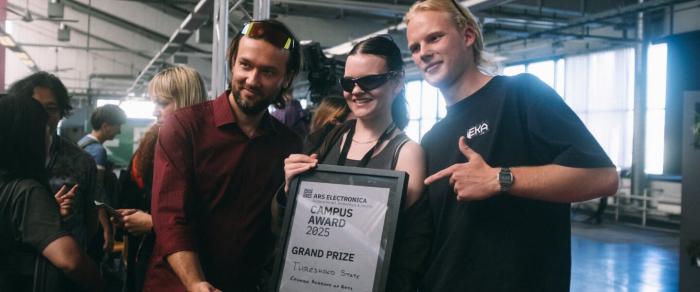Under the collective title “Systems of Unrest,” students from the Estonian Academy of Arts (EKA) and Aalto University joined forces at the Ars Electronica Festival, which took place from September 3 to 7 in Linz, Austria. EKA students won the grand prize at the media art festival Ars Electronica Campus for their work “Threshold State.”

The collaborative exhibition brought together five interdisciplinary installations that explore how people can maintain their agency as technological systems fluctuate between play and panic—a direct response to this year’s main theme of the festival, “Panic. Yes or No?”
EKA students won the grand prize at the festival’s Campus exhibition for their work “Threshold State,” an interactive installation. The installation, depicting a futuristic border point, explores how surveillance and artificial intelligence affect people’s privacy, identity, and agency in the digital age. The authors of the installation are Erik Lond, Tõnis Bender, Ezgi Okka, Mia-Mai Roosberg, Luiza Stibe, Paul Pank, Karl-Alder Kuivjõgi, students of EKA’s Industrial and Digital Product Design and EKA’s Interaction Design. The supervisors were Ottavio Cambieri, Carol Tikerperi, Tanel Kärp and Björn Koop.
Students and lecturers from the EKA’s Faculty of Design and the Faculty of Fine Arts participated in the “Systems of Unrest” project. For the first time, Ars Electronica also collaborated with the Department of New Media at Aalto University.
The winning entry “Threshold State” critically examines the impact of technology and automation on human freedom and identity. The project focuses on a speculative interactive prototype that does not idealize the possibilities of technology, but invites the viewer to think about the ever-growing concerns of a networked society, such as humanity, empathy, ethics, security and privacy, and how worldview and political developments affect us in these areas.
According to Ottavio Cambieri, one of the supervisors of the work, “visitors to the exhibition try to enter a fictitious country called “Threshold State” and fill out a standard border crossing form, which is then scanned and generated by artificial intelligence based on the visitor’s online footprint. Depending on the indicators, entry is either allowed or denied.” Cambieri adds: “we want to know what risks lie in the bias of artificial intelligence and the granting of decision-making power to technology; what does the digital content shared, both intentionally and unintentionally, say about us, and what happens when our digital profile meets a state apparatus whose values are at odds with ours?”
Ars Electronica has been held in Linz, Austria, since 1979, and is one of the world’s most influential digital art festivals, combining art, technology, and society. The festival creates a global platform for artists, scientists, designers, and activists to address the biggest questions of our time and discuss the society of the future through digital technologies. This year, the five-day festival was visited by over 120,000 guests, with 1,472 participants from 83 countries represented with 379 works.
The “Threshold State” border checkpoint can be visited again as part of the DisainiÖÖ festival at the Faculty of Design exhibition in the EKA White House.
More about the “Systems of Disarray” project on the EKA website.
